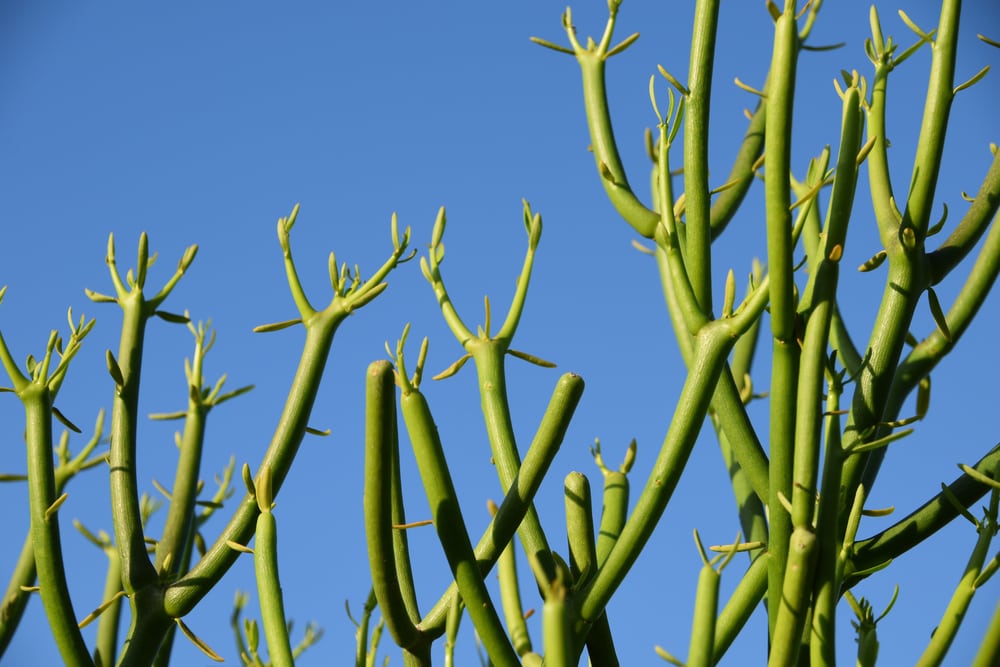How to Propagate Pencil Cactus: 5 Tips & Tricks
-
- Last updated:

The pencil cactus is not really a cactus at all and is, rather, a succulent. It is considered an ideal houseplant because it requires minimal care, grows well when given plenty of sunlight, and its red winter color gives it an attractive appearance that can brighten up any home. However, the pencil cactus does give off a toxic sap and you do need to take care not to come into contact with the sap, which is especially prominent when taking cuttings and pruning.
Below, you will find more information on this succulent, including details on how to care for, prune, and propagate the plant.

About the Pencil Cactus
The pencil cactus grows in regions of Africa and India, where it primarily grows in black soil. It goes by several nicknames, including sticks on fire and the pencil tree. In the wild, this succulent can grow to heights of 20 feet or more, although it can be pruned and maintained closer to 6–7 feet when grown in the home.
If you live in a frost-free area with plenty of natural sunlight, it is possible to grow the pencil tree outdoors and it will bring a flash of color. Otherwise, it can be grown quite easily indoors, as long as you either have a south-facing window with a lot of natural light or the capability to provide suitable artificial light supplementation.
The 5 Tips & Tricks to Propagate Pencil Cactus
To safely propagate a pencil cactus, you will need a pair of strong gloves and safety goggles. You will also need a knife, a suitable planting container, and cactus mix. The best containers offer plenty of drainage for your succulent.
1. Cut the Cactus
Make sure you are wearing safety goggles and gloves, and that you have long sleeves. The sap of the pencil cactus can cause temporary blindness and an instant rash.
Using a sharp knife, cut approximately 5 inches above an intersection where young branches are sprouting.

2. Dry the Cutting
Leave the cutting out to dry somewhere where it receives fresh air and the cut end is allowed to dry off in the air. After about a week, a hardened callous will form and you are ready to move on to the next step.
3. Plant the Cutting
Place cactus mix in your chosen planter and then insert the cutting into the mix, with the cut end under the soil. The pencil should be buried far enough that it can stand on its own and without wobbling over or leaning.

4. Water Lightly
Although the pencil cactus does not require a lot of watering, it will benefit from an initial light watering when it is planted. You should also continue to water it, lightly and only when the soil starts to feel dry, until new growth is evident.
5. Position the New Cactus
Ideally, you should have a south-facing window that receives a lot of natural sunlight over the course of a day. With a pencil cactus, the more light you can give it, the better it will grow. Failing this, you can use a grow lamp or a fluorescent light to give it some extra UV.

Pencil Cactus Care
One of the reasons for the pencil cactus’s popularity is that it is a low-maintenance, high-impact succulent. During the summer months, you should water approximately every 2 weeks or so. Water once a month in fall and don’t water at all during winter.
When the succulent outgrows its pot, you can repot it into something larger. Repot during summer, unless you have to do it sooner. Ensure you are wearing protective gloves and glasses and remove the plant and its roots from the soil. Cut away dead roots and treat with a fungicide before planting it in cactus mix in a larger pot. Try to ensure the same portion of the plant is under the soil as in the original pot and water after about a week.
How Poisonous Is Pencil Cactus?
Pencil cactus can cause vomiting and diarrhea if ingested, and it can cause temporary blindness if it gets in the eye. However, as long as you are careful when cutting, potting, and repotting the plant, it should be generally safe to have around the house and to keep. It is also considered toxic to cats, dogs, and most other animals, so if your pets tend to eat houseplants, it may be best to avoid this particular species.
Can you Touch Pencil Cactus?
It is the plant’s sap that is toxic rather than the exterior of the plant, but this means that you run the risk of transferring any sap into your eyes or your mouth whenever you do touch the plant. As such, it is best to avoid touching it except when necessary and only then when wearing gloves.
Can You Grow a Pencil Cactus Outdoors?
The pencil cactus can grow outdoors but it does require a lot of sun and doesn’t do well with frost or generally cold conditions. Ensure that the plant is in a sunny spot and is not crowded or shaded by other, larger plants. The plant does not need much water, either, so try to ensure it won’t become waterlogged wherever it is situated.

Conclusion
The pencil cactus is, in fact, a succulent, rather than a cactus. But it has a very colorful growth and requires minimal maintenance, which makes it a great addition to suitable gardens and a good choice as an indoor houseplant. However, the sap of the cactus is toxic to people and pets. Ensure you wear protective gloves and even goggles while taking cuttings and give your newly potted pencil cactus as much natural light as you can for the best growth results.
- https://plantcaretoday.com/firestick-plant-toxic.html
- https://www.aspca.org/pet-care/animal-poison-control/toxic-and-non-toxic-plants/pencil-cactus
- https://whyfarmit.com/pencil-cactus/
- https://www.hunker.com/13427705/how-to-propagate-a-pencil-cactus-plant
- https://succulentthrive.com/propagating/pencil-cactus-propagation-guide-4-effective-way-to-propagate/
- https://gardenbeast.com/pencil-cactus-guide/
Featured Image Credit: DMassNYC, Shutterstock
Contents

